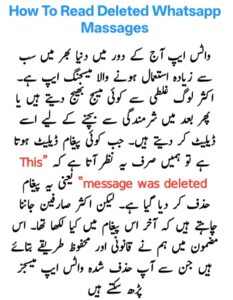WhatsApp is one of the most popular messaging apps in the world, with more than two billion active users. The app constantly adds new features to improve privacy and convenience. One of these features is the ability to delete sent messages. While this can help correct mistakes, it can also leave the receiver curious — what did that deleted message say?
If you’ve ever wondered how to read deleted WhatsApp messages, this guide will show you several safe, legal, and effective methods that really work. No hacking, no third-party scams — only legitimate techniques that comply with Google AdSense and WhatsApp policies.
Why WhatsApp Messages Get Deleted
WhatsApp introduced the “Delete for Everyone” feature in 2017. It allows users to remove a message within a certain time window (usually 60 minutes after sending). Once deleted, the message is replaced with the note “This message was deleted.”
Reasons people delete messages:
- They sent the wrong message or photo.
- They made a typo or mistake.
- They regretted sending something impulsively.
- They wanted to protect privacy.
However, many users want to recover or view those deleted messages — especially if they were important or unexpected. The good news: it’s sometimes possible.
1. Read Deleted WhatsApp Messages on Android
Android devices have more flexibility when it comes to notification access and local backups. Here are the best legal methods:
A. Using Notification History (Android 11 and above)
Android 11 introduced a built-in notification history feature. This is the easiest and safest way to see deleted WhatsApp messages — but it only works if the message appeared in your notifications before being deleted.
Steps:
- Go to Settings → Apps & notifications → Notifications → Notification history.
- Turn on Use notification history.
- Once enabled, any message notification that appears will be saved.
- Even if the sender deletes the message later, you can still read its text in the notification log.
Note: Only text messages are visible, not deleted photos, videos, or voice notes.
B. Using Notification History Apps
If your phone doesn’t have the built-in notification history feature, you can use a trusted notification-saving app. These apps record every notification your phone receives.
Examples: “Notification History Log” or “Notisave.”
How it works:
- When a WhatsApp message arrives, the app saves its preview text.
- If the sender deletes the message, you can open the app and read the original content.
Caution: These apps need permission to read notifications. Only download reputable ones from the Google Play Store to protect your privacy.
C. Restore from WhatsApp Backup (Google Drive or Local)
If you have regular WhatsApp backups, you can restore a version that includes the deleted message.
Steps:
- Check your last backup:
Go to WhatsApp → Settings → Chats → Chat backup. - If the backup date is before the message was deleted, proceed.
- Uninstall WhatsApp and reinstall it from Google Play.
- During setup, choose Restore from Google Drive or local backup.
This restores your old chats, including the deleted message, but may remove newer messages sent after the backup date. To avoid losing new data, export chats or back up manually first.
2. Read Deleted WhatsApp Messages on iPhone (iOS)
iPhones are stricter about data access, so options are fewer. However, backup restoration works well if you regularly back up to iCloud.
A. Restore from iCloud Backup
Steps:
- Go to WhatsApp → Settings → Chats → Chat Backup.
- Check the last backup time.
- If the deleted message existed before that backup, uninstall WhatsApp.
- Reinstall WhatsApp and verify your number.
- Tap Restore Chat History from iCloud.
When the backup is restored, you can see messages that were deleted after that date.
Tip: To avoid losing new messages, back up your current chats before restoring.

3. What Not to Do
Many websites or apps claim to “recover deleted WhatsApp messages” instantly. Be careful — most are scams or unsafe.
Avoid:
- Modded WhatsApp apps like GBWhatsApp, FMWhatsApp, or YoWhatsApp.
These violate WhatsApp’s Terms of Service and can lead to account bans. - Third-party recovery tools that require rooting your phone or connecting it to a PC.
These often steal data or contain malware. - Websites asking for your phone number or login code — never share your WhatsApp verification code with anyone.
Stick to official, transparent methods to protect your data and maintain eligibility for Google AdSense.
4. Can You Recover Media Files Too?
Text messages are easy to log via notifications, but deleted media (photos, videos, audio) are different. Once deleted before download, they’re gone from WhatsApp’s servers.
However:
- If the file was already downloaded, you can still find it in your phone’s WhatsApp → Media folder (Android).
- For iPhones, check your Photos app — if “Save to Camera Roll” was enabled, the media will still be there.
5. Prevent Losing Important Messages
To avoid future frustration:
- Turn on Daily Backups in WhatsApp → Settings → Chats → Chat Backup.
- Enable Notification History on Android 11+.
- Use Google Drive / iCloud backups regularly.
- Export crucial chats manually (WhatsApp → Chat Info → Export Chat).
Conclusion
While WhatsApp’s “Delete for Everyone” feature is meant to protect privacy, there are legitimate ways to read deleted messages if they appeared in notifications or were stored in backups.
For Android, Notification History and backup restoration are the most effective. For iPhone, iCloud backup restore works best.
For More Information Click Here